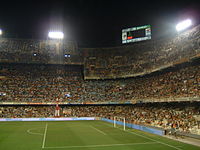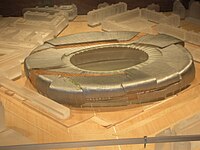Valencia played its first years at the Algirós stadium but moved to the Mestalla in 1923. In the 1950s, Mestalla was restructured, which resulted in a capacity increase to 45,000 spectators. Today it holds 55,000 seats. However, Valencia is scheduled to move to a new stadium in the north-west of the city Valencia in 2010. The Nou Mestalla, as it will be called, will hold around 75,000 spectators and will be given a 5 star status by FIFA. It ranks as the fifth largest stadium in Spain. It is also renowned for its steep terracing and for being one of the most intimidating atmospheres in all of Europe to play.
On 20 May 1923, the Mestalla pitch was inaugurated with a friendly match that brought Valencia CF and Levante UD face to face. It was the beginning of a new era that meant farewell to the old place, Algirós, which will always remain in the memories of the Valencians as first home of the club. A long history has taken place on the Mestalla field since its very beginning, when the Valencia team was not yet in the Primera División. Back then, this stadium could hold 17,000 spectators, and in that time the club started to show its potential in regional championships, which led the managers of that time to carry out the first alterations of Mestalla in 1927. The stadium's total capacity increased to 25,000 before it became severely damaged during the Civil War.
Mestalla was used as concentration camp and junk warehouse. It would only keep its structure, since the rest was a lonely plot of land with no terraces and a stand broken during the war. Once the Valencian pitch was renovated, Mestalla saw how the team managed to bring home their first title, the 1941 Cup. An overwhelming team was playing on the grass of the redesigned Valencian stadium in that decade, team that conquered three League titles and two Cups with the legendary ‘electric forwards’ of Epi, Amadeo, Mundo, Asensi and Guillermo Gorostiza. Those years of sporting success also served as support to recover little by little the Mestalla ground.
During the decade of the fifties, the Valencia ground experienced the deepest change in its whole history. That project resulted in a stadium with a capacity of 45,500 spectators. It was a dream that was destroyed by the flood that flooded Valencia in October 1957 after the overflowing of the Turia River. Nevertheless, Mestalla not only returned to normality, but also some more improvements were added, like artificial light, which was inaugurated during the 1959 Fallas festivities. This was the beginning of a new change for the Mestalla.
During the sixties, the stadium kept the same appearance, whilst the urban view around it was quickly being transformed. Moreover, the Valencian domain became from that moment on, the setting of big European feats. Nottingham Forest was the first foreign team that played an official match in Mestalla with the "Che" club. They played on 15 September 1961 and it was the first clash of a golden age full of continental successes, reinforced with the Fairs Cup won in 1962 and 1963. Mestalla had just entered the European competitions as a stadium where the most important events were taking place.
From 1969, the expression "Anem a Mestalla" (Let’s go to Mestalla), so common among the supporters, started to fall into oblivion. The reason was the change of name that meant a big tribute that the club paid to his most symbolic president that lasted for a quarter of a century. Luis Casanova Giner admitted that he was completely overwhelmed by such honour, and the president himself requested in 1994 that his name was again replaced by the name of Mestalla, as it happened. At the beginning of the seventies, the local bench of the back-then-called Luis Casanova stadium was occupied by Alfredo Di Stéfano, whose results were the winning of one League competition, one second place in the League and two Cup finals lost by the minimum difference. Moreover, Valencia participated for the first time in the European Cup and made their debut in the UEFA Cup. It all was a series of events that made that every match in the stadium located in Suecia Avenue turned into a big party.
In 1972, the head office of the club, located in the back of the numbered terraces, was inaugurated. It consisted of an office of avant-garde style with a worth mentioning trophy hall, which held the foundation flag of the club. In the summer of 1973 there was another new thing, the goal seats, which meant the elimination of fourteen rows of standing terraces providing more comfort and an adjustment to the new times. Valencia's management started to consider the possibility of moving Mestalla from its present location to some land in the outskirts of the town, but finally the project was turned down and some years later.
At that time, Mario Kempes, subsequently considered one of the greatest footballers in the world by Pele was playing for Valencia. With the Matador in its team, Valencia won the Copa del Rey, the Cup Winners Cup and European Super Cup in consecutive years. The "Che" team became continental superchampion in the last European final played in Mestalla. It was in 1980 against Nottingham Forest, which oddly enough was the first foreign team that had played an official match in the Valencian stadium.
Mestalla, which in 1925 had held the first match of the Spain national football team in Valencia, was chosen as the setting for the debut of Spain in the 1982 World Cup, although the performance of the combined national team was not finally what was expected. Ten years later, the Olympic team would look for support in the Valencian stadium, this time with a very different result, since the selected young footballers finally got the gold medal in the 1992 Summer Olympics held in Barcelona.
Mestalla has been the setting for important international matches, has held several Cup finals, has been seat for Levante UD, home of the Spanish national team and exile for Castellón and Real Madrid in the European Cup.
2008–2009 was to have been the last season at the Mestalla, with the club moving to their new 75,000-seater stadium Nou Mestalla in time for the 2009–2010 season. However, the club is in financial crisis, and work on the new stadium has stopped.
Career statistics
-
By season
Season Class Bike Team Race Win Pod Pole FLap Pts Plcd WCh
1996 125cc Aprilia RS125 Scuderia AGV Aprilia 15 1 2 1 2 111 9th 0
1997 Aprilia RS125...
14 years ago



0 comments:
Post a Comment